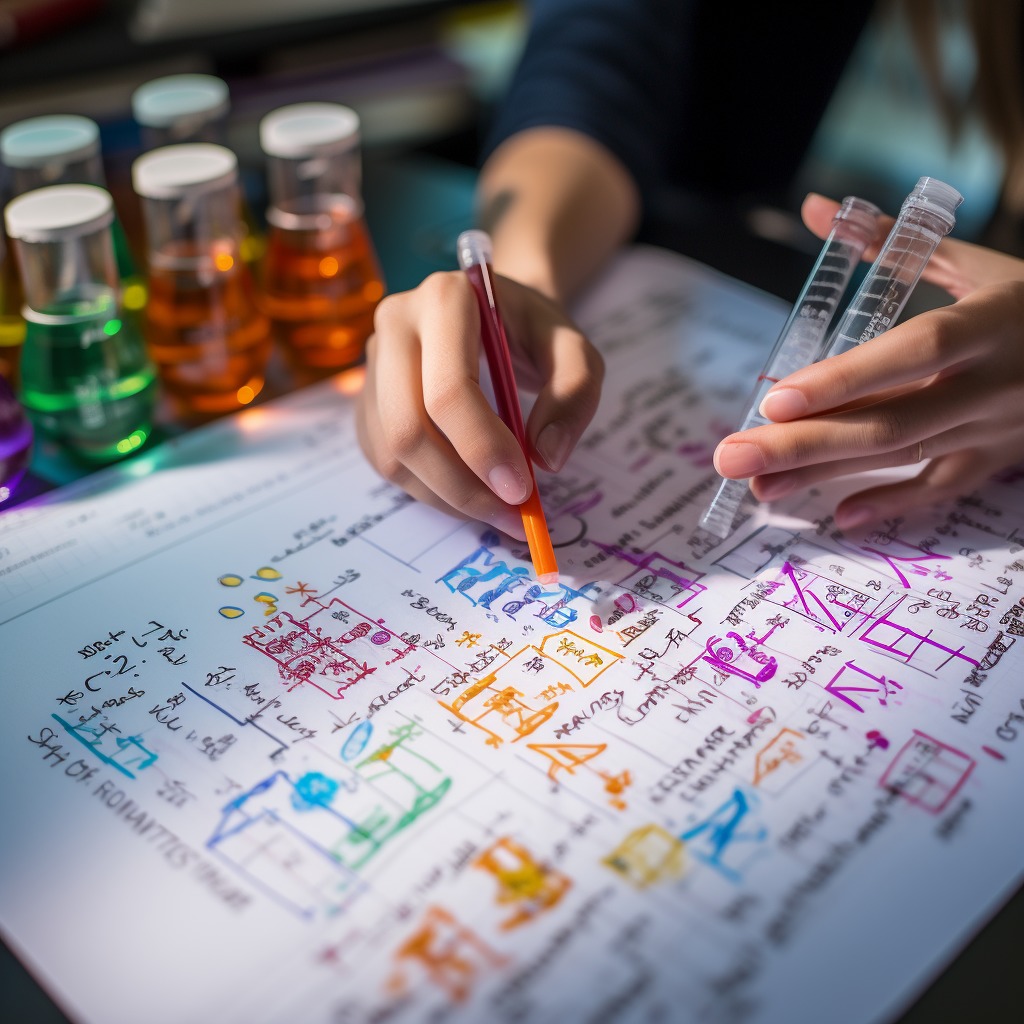
Chemical equations are the backbone of chemistry, serving as scientists’ shorthand to describe complex reactions. But what happens when these equations are out of balance? Just like a seesaw that’s unevenly weighted, an unbalanced chemical equation can throw your understanding of a reaction off-kilter. Balancing these equations is not just a classroom exercise; it’s a fundamental skill with real-world applications.
Discover your ideal chemistry tutor at meet’n’learn and skyrocket your understanding to new heights!
A Beginner’s Guide to Chemical Equations
This blog aims to demystify the art and science of balancing chemical equations. Whether you’re a student grappling with your chemistry homework, a teacher looking for effective ways to explain this concept, or a chemistry tutor wanting to deepen your understanding, this guide is for you.
Here’s a glimpse of what you’ll learn:
- Understanding the basics of chemical equations
- Why balancing chemical equations is crucial
- A step-by-step guide to balancing equations
- Common mistakes and how to avoid them
- Real-world applications of balanced chemical equations
- The role of tutors in mastering this skill
Want to expand your chemistry horizons? Our World of Chemistry offers a plethora of free educational blogs.
Understanding Chemical Equations: The Foundation
Before we dive into the nitty-gritty of balancing, it’s crucial to understand a chemical equation. Think of it as a recipe in a cookbook but for chemists. It tells you what you need (reactants) and what you’ll end up with (products).
A chemical equation is written with the reactants on the left-hand side, an arrow pointing towards the right, and the products on the right-hand side. For example, the equation for the reaction between hydrogen and oxygen to form water is written as H2 + O2 → H2O.
Simple, right? Not so fast. This equation is actually unbalanced. Balancing it ensures that the same number of atoms for each element are present on both sides, adhering to the Law of Conservation of Mass.
Explore Halogenides, Sulfides, and Hydroxides.
Components of a Chemical Equation:
- Reactants: The substances that undergo a change.
- Products: The substances that are formed.
- Coefficients: The numbers in front of the chemical formulas. They indicate the number of molecules or atoms.
- Subscripts: The small numbers within the chemical formulas that tell you the number of atoms in a molecule.
Understanding these components is the first step in mastering the skill of balancing chemical equations. It sets the groundwork for everything that follows.
How to calculate Molar Mass, Mass Fraction, and Viscosity?
Why Balancing Chemical Equations Matters
Now that you’re familiar with a chemical equation’s structure, you might wonder, “Why do I need to balance it?” The answer lies in a fundamental principle known as the Law of Conservation of Mass. This law states that a chemical reaction cannot create or destroy matter. In simpler terms, what goes in must come out.
When you balance a chemical equation, you ensure that the same number of atoms for each element are on both sides. This is not just a theoretical exercise; it has practical implications. For instance, an unbalanced equation can lead to incorrect measurements and failed experiments if you’re working in a lab. In industrial settings, this could translate to wasted resources and increased costs.
Ethanol and Alcohols in Chemistry explained.
Here are some key reasons why balancing chemical equations is essential:
- Accuracy in Scientific Experiments: An unbalanced equation can throw off the entire experiment, leading to incorrect conclusions.
- Resource Management: In industries, precise equations are necessary for calculating the exact amount of reactants needed, minimizing waste.
- Safety: Incorrect equations can be hazardous in experiments involving toxic or volatile substances.
- Educational Importance: Balancing equations is a foundational skill in chemistry education, helping students understand more complex topics later on.
As you can see, balancing chemical equations is not just an academic exercise; it’s a skill with real-world applications that can impact various aspects of life and work.
Explore Acids, Bases, pH, master Acid-Base Titration, and learn to Calculate Solution Concentrations.
How to Balance Chemical Equations: A Comprehensive Guide
Understanding how to balance chemical equations is a fundamental skill in chemistry. In this guide, we’ll walk you through the steps to balance the equation for the combustion of hydrogen gas to form water, represented as H2 + O2 → H2O. We’ll incorporate this example into each step to make the process easier to grasp.
- Identify the Reactants and Products: Start by writing down the unbalanced equation. In our example, it’s H2 + O2 → H2O.
- Count the Atoms: Tally up the atoms for each element on both sides. Here, we have 2 hydrogen atoms and 2 oxygen atoms on the left and 2 hydrogen atoms and 1 oxygen atom on the right.
- Begin with Complex Molecules: Balance the atoms in the most complex molecule first. In this simple example, each molecule contains only one type of atom so we can move on.
- Utilize Coefficients: Add coefficients before the chemical formulas to balance the atoms. For our equation, adding a coefficient of 2 before H2O on the right balances it: H2 + O2 → 2H2O.
- Verify the Equation: Double-check the atoms to confirm they are balanced. Now, both sides have 2 hydrogen atoms and 2 oxygen atoms.
- Minimize Coefficients: If possible, reduce the coefficients to their smallest whole numbers. In this case, they are already at their minimum.
- Final Verification: Perform a last check to ensure the equation is balanced. The equation H2 + O2 → 2H2O is confirmed to be balanced.
This step-by-step guide, illustrated with a practical example, aims to provide a solid understanding of how to balance chemical equations. This skill is indispensable in both academic and professional settings.
Discover how Hydrogen Bonds and Covalent Bonds are formed, and learn to Differentiate Them from Ionic Bonds.
Pitfalls in Balancing Chemical Equations and How to Dodge Them
Even seasoned chemists can stumble when balancing equations. Here are some frequent errors and how to sidestep them:
- Altering Subscripts: Changing subscripts instead of coefficients is a cardinal sin in chemistry. This alters the substance itself. Solution: Always adjust coefficients, never subscripts.
- Ignoring Physical States: Forgetting to consider the physical states (s, l, g, aq) can lead to inaccuracies in certain calculations. Solution: Always note the physical states and include them in your balanced equation.
- Overthinking Simple Equations: Beginners often add unnecessary steps, complicating the process. Solution: Stick to the basics. Start by balancing the most complex molecule first and work your way down.
- Skipping Coefficient Minimization: After balancing, some forget to reduce coefficients to their smallest whole numbers. Solution: Always simplify coefficients as the final step.
- Assuming 1:1 Ratios: Not all balanced equations have 1:1 stoichiometric ratios. Solution: Always double-check your ratios to ensure they align with the balanced equation.
By being aware of these pitfalls and their solutions, you’ll be better equipped to balance chemical equations accurately.
What are Functional Groups in organic chemistry?
Discover the chemistry behind Water and Photosynthesis.
Putting Knowledge to Work: Applications and Uses of Chemical Equations
Understanding how to balance chemical equations isn’t just academic; it has real-world applications that are often crucial for various industries.
- Pharmaceuticals: Accurate equations are vital for drug formulation.
- Environmental Science: Balancing equations helps in understanding chemical reactions in ecosystems.
- Energy Production: In power plants, balanced equations are essential for efficient energy output.
- Food Industry: Ensures consistent quality and taste.
- Material Science: Used in developing new materials with desired properties.
Whether you’re a budding scientist or an industry professional, mastering the art of balancing chemical equations is indispensable.
Check out 8 Exciting Science Experiments for Kids and unravel The Greatest Discoveries in Biology.
Introduction to the Periodic Table and how to memorize it.
Role of Tutors in Mastering Chemical Equations
While textbooks and lectures lay the groundwork, the role of a tutor in mastering the art of balancing chemical equations is indispensable. Tutors offer a more nuanced and personalized approach to learning this essential skill. Here are some key aspects where tutors make a significant difference:
- Personalized Guidance: Tutors provide one-on-one sessions tailored to your specific needs. They can identify your weak areas and focus on strengthening them, ensuring a more comprehensive understanding of the subject.
- Real-Time Clarification: Unlike classroom settings where you might hesitate to ask questions, tutors offer the opportunity for real-time clarification. Any doubts can be immediately addressed, making the learning process smoother and more effective.
- Hands-On Practice: Tutors offer practical exercises that go beyond theoretical knowledge. They can introduce you to a variety of chemical equations, from the simple to the complex, providing a well-rounded skill set.
- Advanced Techniques: Once you’ve grasped the basics, tutors can introduce advanced techniques and shortcuts. These can make balancing equations quicker and more efficient, a skill that proves invaluable in academic and professional settings.
- Real-World Applications: Tutors can also make the subject matter more relatable by providing real-world examples where balanced equations are crucial. This enhances understanding and underscores the importance of mastering this skill.
Looking for a chemistry tutor? Enter “chemistry tutor Glasgow” or “chemistry teacher Sheffield” on your preferred tutoring platform, such as meet’n’learn to find a teacher who can meet your specific needs.
If you thrive in group learning environments, search “chemistry classes London” or “chemistry lessons Manchester” online to discover local schools offering chemistry lessons.
In summary, tutors offer a multi-faceted approach to learning how to balance chemical equations, transforming you from a novice to an adept practitioner.
How a tutor can help Make Science Fun.
Discover the fundamentals of Electrochemistry and Redox Reactions.
The Last Word on Chemical Equations & Balancing
By now, you should have a solid grasp of what balancing chemical equations entails, the common pitfalls to avoid, and the real-world applications of this essential skill. But remember, mastery doesn’t come overnight. It requires consistent practice, and, as we’ve discussed, the guidance of a skilled tutor can be invaluable in this journey.
Chemical equations serve as the language of chemistry, describing what happens during a chemical reaction. Understanding how to balance these equations is not just an academic exercise; it’s a fundamental skill with wide-ranging applications in various fields, from pharmaceuticals to environmental science.
So, don’t stop here. Continue to practice, seek guidance, and apply what you’ve learned in real-world scenarios. The more you engage with the subject, the more proficient you’ll become. And who knows? This skill could be the stepping stone to a fulfilling career in science.
Struggling with biology topics? Explore our extensive collection of biology educational blog posts designed to simplify complex concepts for you. Whether it’s photosynthesis, the intricacies of green algae, understanding bacteria and viruses, or delving into the fascinating world of genetics and cells, our resources have got you covered. Expand your knowledge and enhance your learning journey with us today.
Frequently Asked Questions About Chemical Equations & Balancing
1. What is the Law of Conservation of Mass?
The Law of Conservation of Mass states that a chemical reaction cannot create or destroy matter. This is why equations must be balanced to reflect the same amount of each element on both sides.
2. Why is it important to balance chemical equations?
Unbalanced equations are not representative of actual chemical reactions. Balancing ensures that the same amount of matter is present before and after the reaction, adhering to the Law of Conservation of Mass.
3. Can chemical equations be balanced by trial and error?
Yes, trial and error is one of the methods to balance chemical equations, especially for simpler ones. However, for more complex equations, algebraic methods are often more efficient.
4. What is a coefficient in a chemical equation?
Coefficients are numbers placed before the chemical formulas to indicate the number of molecules or atoms involved in the reaction.
5. How can a tutor help in mastering chemical equations?
A tutor can provide personalized guidance, hands-on practice, and advanced techniques to help you master the skill of balancing chemical equations.
6. Are there any software tools for balancing equations?
Yes, there are software and online tools available that can balance chemical equations. However, manual balancing is essential for a deep understanding of the subject.
7. Is balancing chemical equations relevant in real-world applications?
Absolutely. Balanced chemical equations are crucial in medicine, environmental science, and manufacturing.
8. What are some common mistakes in balancing equations?
Common mistakes include neglecting to balance all elements, changing subscripts instead of coefficients, and not double-checking the work.
Discover your ideal chemistry tutor at meet’n’learn and skyrocket your understanding to new heights!


